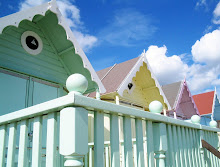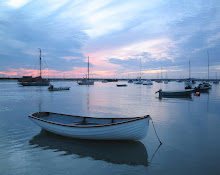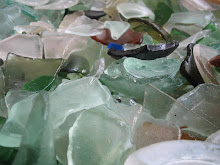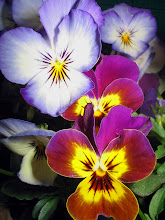 I've enjoyed rediscovering and sharing some of the vintage children's books I've inherited. Here's one I scooped up years ago in a junk shop in Chelmsford (long since gone) - Mrs Leicester's School by Charles and Mary Lamb, with illustrations by Winifred Green, published by J M Dent in 1899.
I've enjoyed rediscovering and sharing some of the vintage children's books I've inherited. Here's one I scooped up years ago in a junk shop in Chelmsford (long since gone) - Mrs Leicester's School by Charles and Mary Lamb, with illustrations by Winifred Green, published by J M Dent in 1899. The best-known collaboration between Charles Lamb and his sister Mary is their Lamb’s Tales from Shakespeare.
The best-known collaboration between Charles Lamb and his sister Mary is their Lamb’s Tales from Shakespeare.
Mrs Leicester’s School was first published in 1809. There’s an excellent essay here, which describes and explains the structure of the original publication and from which the following is a quote:
Mrs. Leicester's School contains ten separate inset tales bound together by the frame narrative which almost wholly recedes by the later stories. This frame is constructed in the 'Dedication' . . . and establishes that the tales are those told by pupils in a school, later written down by their teacher. This structure is similar to that used by Boccaccio in the Decameron, but a greater debt is owed to Sarah Fielding's The Governess (1749). The authors come close to admitting this when they have their narrator, the young teacher, explain that she had read 'in old authors,' - by whom she might mean Fielding (but could just as well be referring to Boccaccio or Chaucer's Canterbury Tales) - 'that it was not infrequent in former times, when strangers were assembled together ... for them to amuse themselves with telling stories, either of their own lives, or the adventures of others' . . . The Lambs' governess' plan is for each child who has come to the school, and is currently lonely and frightened, to tell the story of their life to the assembled class. This will break the ice and, of course, allow plenty of scope for moral and didactic observations.
You can read the whole of the text of Mrs Leicester's School here .
Mary (1764–1847) wrote seven of the stories and Charles (1785-1834) three - 'The Effect of Witch Stories', 'First Going to Church' and 'The Sea Voyage'. Mary suffered from bipolar disorder, murdered her mother and spent a lot of her life in mental institutions, though Charles looked after her himself as best he could.

As a child, I was presented with a copy of Lamb’s Tales by one of my godmothers, but have never really thought about it since I was 12, nor explored the lives of the authors. Suddenly, I feel inspired to add the books reviewed here to my TBR pile. I can’t think why I haven’t already acquired (if not read) Peter Ackroyd’s The Lambs of London, since I’m usually a snapper-up of Ackroyd’s novels, but this one somehow passed me by – a situation which will shortly be remedied.

I’ve also just added Kathy Watson’s The Devil Kissed Her: The Story of Mary Lamb to my bulging Amazon shopping trolley (it’s a double-decker one and will fall right over with a big crash one of these days).

Mrs Leicester’s School is also considered in this highly recommended book, Opening the Nursery Door – which I have a copy of somewhere but annoyingly cannot lay my hands on it (but, as regular visitors know, the disordered state of my bookshelves is legendary).

Anyway, all the above is digressive. I bought my 1899 copy of Mrs Leicester’s School twenty-odd years ago, purely for the delightful chromolithograph colour plates by Winifred Green. As you can see, these are very (very) much in the style of Kate Greenaway.

 While the style of the costumes in the illustrations would have been ‘old fashioned’ for 1899 – all high-waisted dresses, bonnets and huge mob caps, they were of course vaguely in keeping with the Regency world of the Lambs. I suspect that this nod towards ‘historical accuracy’ would, however, have been secondary to fact that this kind of idyllic children’s never-land was hugely popular at the time – the principal exponents being Randolph Caldecott, Walter Crane (this links to a Crane site that's elegant, animated and gorgeous) and, as already mentioned, the prolific Kate Greenaway .
While the style of the costumes in the illustrations would have been ‘old fashioned’ for 1899 – all high-waisted dresses, bonnets and huge mob caps, they were of course vaguely in keeping with the Regency world of the Lambs. I suspect that this nod towards ‘historical accuracy’ would, however, have been secondary to fact that this kind of idyllic children’s never-land was hugely popular at the time – the principal exponents being Randolph Caldecott, Walter Crane (this links to a Crane site that's elegant, animated and gorgeous) and, as already mentioned, the prolific Kate Greenaway .
Here’s a review of the Winifred Green/Dent edition which appeared in the NYT on Wednesday 2 December 1899 (NB I have applied to the NYT several times in past months for permission to reproduce this on my blog, but answer comes there none. Not a ‘yes’. But on the other hand, not a ‘No’, either. If this finally prompts them to get in touch and demand that I remove it, then of course I will do so, while grinding my teeth at the irony. But it may never happen.)
Finally, here's the delightful inscription in my copy:

It's a whole story in itself! If your ancestors lived at Colne Priory or you can identify 'Heaven' - do please get in touch.























4 comments:
How delightful to return home and find this and the Peto post, Juliet. I am going to be enthralled for days, enjoying the illustrations and following the links. I have a copy of Kate Greenaway's 'Under the Window' and can see the similarity with the Winifred Green illustrations. I can't wait to see what other gems you have on your shelves.
Hi i have reccently discovered an oil painting signed Dudley Heath, and done a bit of research, his first wife was a winifred green (the painting is actually of a william green, so perhaps a relation?) please have a look at this link - http://www.jjhc.info/heathernestdudley1945.htm
Hi Juliet'
I am afraid you are on the wrong track with this supposed husband Ernest Dudley Heath. Winifred Green's maiden name was Winifred Smith. Under that name she illustrated at least two delightful children's books: 1)Children's singing games. With the tunes to which they are sung. Collected and edited by Alice B.Gomme,1894 2) Nursery songs and rhymes of England,1895; both "pictured in black and white by Winifred Smith" and both "published by David Nutt in the Strand". (I,m still looking for nr.1). The only information I could find about her (even in Brigid Peppin/Lucy Micklethwait she is not mentioned) is in "Die Kinderwelt im Kinderbuch. Kinder- und Jugendbücher aus fünf Jahrhunderten; Köln, 1988": (translated) "Winifred Smith, who, after her marriage, illustrated children's books under the name of Winifred Green," (Couldn't she find a husband with a slightly more exclusive name, it makes googling so awkward, especially her being a Smith) "was a representative of the influential Birmingham school of illustration". And the only information about Winifred Green I could google up was your blog. Thank you for that. The Birmingham link might be correct. Her black and white work looks like Arthur Gaskin and Louis Fairfax Muckley both associated with the Birmingham School of Handicraft. Googling there I found a Birmigham silversmith Charles S.Green & Co, from 1907 onward located Cogent Works 54, St.Paul Square. "He was assisted in the business by his wife Winifred" (alas no maiden name), "a talented artist who designed all the firms early patterns". Considering the beautiful borders she made in her books this might be our Winifred. This also would acount for her obscurity in bibliographical survey's: after those (3?) books she went into another profession.
Once more, thank you for your nice entry on Mrs W.Green-Smith.
Bas Maliepaard, Schiedam, Holland.
Hello Juliet,
Having recently written an MA dissertation on the topic of Arts and Crafts Children's Book-Illustration, I can confirm that Winifred Green (born Smith, dates however unknown) was a student at the Birmingham School of Art in the 1890s and would have trained in the art of book-illustration under Arthur J. Gaskin. The 'Birmingham School', interestingly with a strong female representation, became known for their work in black and white. For references and examples of other works by Winifred Smith see 'The Birmingham Municipal School of Art', The Studio 2 (1894), pp. 90-99; R.E.D. Sketchley, English Book-Illustration of To-day (London: Kegan, Paul, Trenchner, Trubner and Co, 1903), p. 101; Simon Houfe, The Dictionary of British Book Illustrators and Caricaturists. 1800-1914 (Woodbridge: Antique Collectors' Club, 1978), p. 459.
Regards, C.
Post a Comment